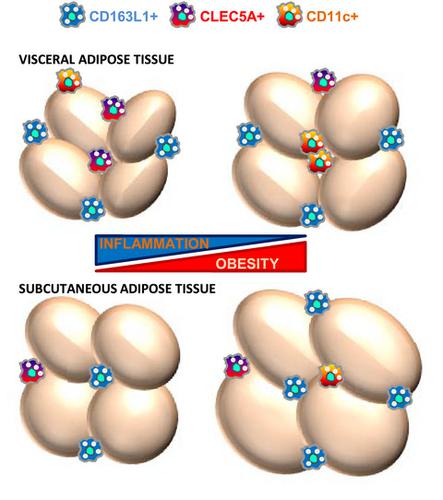当前位置:
X-MOL 学术
›
Immunol. Cell Biol.
›
论文详情
Our official English website, www.x-mol.net, welcomes your
feedback! (Note: you will need to create a separate account there.)
Specific macrophage subsets accumulate in human subcutaneous and omental fat depots during obesity.
Immunology and Cell Biology ( IF 3.2 ) Pub Date : 2020-07-22 , DOI: 10.1111/imcb.12380 Angélica Girón-Ulloa 1 , Erika González-Domínguez 1 , Rebeca S Klimek 1 , Eduardo Patiño-Martínez 1 , Germán Vargas-Ayala 2 , Norma C Segovia-Gamboa 1 , Victoria Campos-Peña 3 , Martha E Rodríguez-Arellano 4 , Marco A Meraz-Ríos 1 , Salvador F Campos-Campos 5 , Carmen Sánchez-Torres 1
Immunology and Cell Biology ( IF 3.2 ) Pub Date : 2020-07-22 , DOI: 10.1111/imcb.12380 Angélica Girón-Ulloa 1 , Erika González-Domínguez 1 , Rebeca S Klimek 1 , Eduardo Patiño-Martínez 1 , Germán Vargas-Ayala 2 , Norma C Segovia-Gamboa 1 , Victoria Campos-Peña 3 , Martha E Rodríguez-Arellano 4 , Marco A Meraz-Ríos 1 , Salvador F Campos-Campos 5 , Carmen Sánchez-Torres 1
Affiliation

|
Obesity is a chronic inflammatory disease associated with adipose tissue macrophage (ATM) activation. ATMs from lean mice contribute to tissue homeostasis by their M2‐oriented polarization, whereas obesity leads to an increase of M1 inflammatory ATMs that underlies obesity‐related metabolic disorders. In humans, studies characterizing ATMs and their functional status are limited. Here we investigated ATM phenotype in visceral (VAT) and subcutaneous (SAT) adipose tissue from healthy lean and obese individuals using two molecules previously identified as markers of M1‐like and M2‐like/tissue‐resident macrophages, the C‐type lectin CLEC5A and the scavenger receptor CD163L1, respectively. CD163L1 was expressed by the majority of ATMs, and CD163L1+ ATM density was greater with respect to cells expressing the pan‐macrophage markers CD68 or CD11b. ATM counts in SAT, but not in VAT, increased in obese compared to lean individuals, measured with the three markers. Accordingly, CD163L1, CD68 and ITGAM gene expression was significantly enhanced in obese with respect to control individuals only in SAT. CLEC5A+ ATMs had a proinflammatory profile and were abundant in the lean VAT, but their density diminished in obesity. The only ATM subset that increased its counts in the obese VAT had a mixed M1‐like (CD11c+CD163−CD209−) and M2‐like (CLEC5A−CD206+) phenotype. ATM expansion was dominated by a subset of M2‐like macrophages (CD11c−CLEC5A−CD163+CD206+CD209+) in the obese SAT, with a minor contribution of a CD11c+CLEC5A− ATM subpopulation. Thus, both SAT and VAT seems to limit inflammation during obesity by differentially altering their ATM subset composition.
中文翻译:

在肥胖期间,特定的巨噬细胞亚群在人皮下和网膜脂肪库中积累。
肥胖是一种与脂肪组织巨噬细胞 (ATM) 激活相关的慢性炎症性疾病。来自瘦小鼠的 ATM 通过其 M2 定向极化有助于组织稳态,而肥胖导致 M1 炎症 ATM 增加,这是肥胖相关代谢紊乱的基础。在人类中,描述 ATM 及其功能状态的研究是有限的。在这里,我们使用先前鉴定为 M1 样和 M2 样/组织驻留巨噬细胞标志物的两种分子,即 C 型凝集素 CLEC5A,研究了来自健康瘦人和肥胖个体的内脏 (VAT) 和皮下 (SAT) 脂肪组织中的 ATM 表型和清道夫受体 CD163L1。CD163L1 由大多数 ATM 表达,CD163L1 +对于表达泛巨噬细胞标志物 CD68 或 CD11b 的细胞,ATM 密度更大。与瘦人相比,SAT 中的 ATM 计数增加,但在 VAT 中没有增加,用三个标记来衡量。因此,CD163L1、CD68和ITGAM基因表达在肥胖中仅在SAT中相对于对照个体显着增强。CLEC5A + ATMs 具有促炎特征,并且在瘦肉增值税中含量丰富,但在肥胖时它们的密度降低。唯一增加肥胖增值税计数的 ATM 子集具有混合 M1 样(CD11c + CD163 - CD209 -)和 M2 样(CLEC5A - CD206 +) 表型。在肥胖 SAT 中,ATM 扩增由 M2 样巨噬细胞亚群(CD11c - CLEC5A - CD163 + CD206 + CD209 +)主导,CD11c + CLEC5A - ATM 亚群的贡献较小。因此,SAT 和 VAT 似乎都通过不同地改变它们的 ATM 子集组成来限制肥胖期间的炎症。
更新日期:2020-07-22
中文翻译:

在肥胖期间,特定的巨噬细胞亚群在人皮下和网膜脂肪库中积累。
肥胖是一种与脂肪组织巨噬细胞 (ATM) 激活相关的慢性炎症性疾病。来自瘦小鼠的 ATM 通过其 M2 定向极化有助于组织稳态,而肥胖导致 M1 炎症 ATM 增加,这是肥胖相关代谢紊乱的基础。在人类中,描述 ATM 及其功能状态的研究是有限的。在这里,我们使用先前鉴定为 M1 样和 M2 样/组织驻留巨噬细胞标志物的两种分子,即 C 型凝集素 CLEC5A,研究了来自健康瘦人和肥胖个体的内脏 (VAT) 和皮下 (SAT) 脂肪组织中的 ATM 表型和清道夫受体 CD163L1。CD163L1 由大多数 ATM 表达,CD163L1 +对于表达泛巨噬细胞标志物 CD68 或 CD11b 的细胞,ATM 密度更大。与瘦人相比,SAT 中的 ATM 计数增加,但在 VAT 中没有增加,用三个标记来衡量。因此,CD163L1、CD68和ITGAM基因表达在肥胖中仅在SAT中相对于对照个体显着增强。CLEC5A + ATMs 具有促炎特征,并且在瘦肉增值税中含量丰富,但在肥胖时它们的密度降低。唯一增加肥胖增值税计数的 ATM 子集具有混合 M1 样(CD11c + CD163 - CD209 -)和 M2 样(CLEC5A - CD206 +) 表型。在肥胖 SAT 中,ATM 扩增由 M2 样巨噬细胞亚群(CD11c - CLEC5A - CD163 + CD206 + CD209 +)主导,CD11c + CLEC5A - ATM 亚群的贡献较小。因此,SAT 和 VAT 似乎都通过不同地改变它们的 ATM 子集组成来限制肥胖期间的炎症。











































 京公网安备 11010802027423号
京公网安备 11010802027423号